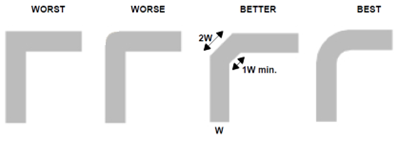Pattern Sharp Angle
This rule searches for routing angles that are sharper than the specified reference angle.
- Item: Input item name.
- Net: Select a target net group.
- Exclude Net: Exclude net group by net group name. Normally, the Power and Ground net should be excluded.
- Condition: Specify a sign of inequality for check pattern angle.
- Angle: Assign a reference angle.
- Ignore Short Pattern: The trace shorter than this will be ignored.
- Pin Escape: Enter a radius of circular region around pins to be excluded for the rule check.
- Long Straightened Pattern Check: Check if signal trace straightened longer than this value.
- Copper Boundary Line Width Check: Check the boundary line width of polygon. If boundary line width equals zero, it reports as failed.
Effects of Sharp Angle Bend
- Reflections
- Primarily due to change of width at the corner (1.414 times increase at the apex for 90-degree bend).
- Upsets the transmission line characteristics, especially distributed capacitance and self-Inductance.
- Acts like a capacitive load attached to the transmission line.
- Rounding the bend with a constant width reduces reflection and rise-time. Simpler to chamfering the corner to 45 degrees.
- EMC Failure
- At high frequencies, the sharp corners may cause EMC failure.
- Acid Trap
-
Sharp corners tend to retain enchant during the PCB manufacturing process.
- Etching in sharp corners becomes difficult to rinse and can cause delayed action of etching.
- For narrow traces, over-etching on the inside of the bend eats away
a higher percentage of the available copper than for wider
traces.
 Figure 1.
Figure 1.
-